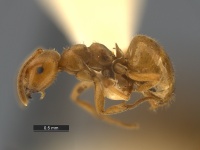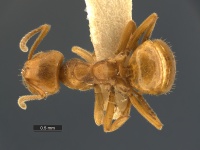Lasius speculiventris
| Lasius speculiventris | |
|---|---|

| |
| Scientific classification | |
| Kingdom: | Animalia |
| Phylum: | Arthropoda |
| Class: | Insecta |
| Order: | Hymenoptera |
| Family: | Formicidae |
| Subfamily: | Formicinae |
| Tribe: | Lasiini |
| Genus: | Lasius |
| Section: | flavus clade |
| Species group: | umbratus |
| Species: | L. speculiventris |
| Binomial name | |
| Lasius speculiventris Emery, 1893 | |
This rarely collected ant nests in rotten logs in bogs, fens, and moist woodlands. It has been reported to be a social parasite of the social parasite Lasius minutus; such social hyperparasitism is rare in ants. Very little is known of the natural history of this rarely encountered species. (Ellison et al., 2012)
| At a Glance | • Temporary parasite |
Photo Gallery
Identification
Closely related to Lasius umbratus, but differing by the shiny second segment of the gaster that lacks appressed pubescence and the tendency toward denser cephalic and appendage pilosity.
Keys including this Species
- Key to Lasius Nearctic workers with long maxillary palpi
- Key to Lasius males
- Key to Lasius queens
- Key to North American Lasius Species
- Key to New England Lasius
Distribution
This northern species has been collected from the northeastern and Great Lakes states. It is recorded from southern New England. It is most common in the Great Lakes district.
Latitudinal Distribution Pattern
Latitudinal Range: 48.771° to 35.61°.
| North Temperate |
North Subtropical |
Tropical | South Subtropical |
South Temperate |
- Source: AntMaps
Distribution based on Regional Taxon Lists
Nearctic Region: United States (type locality).
Distribution based on AntMaps
Distribution based on AntWeb specimens
Check data from AntWeb
Countries Occupied
| Number of countries occupied by this species based on AntWiki Regional Taxon Lists. In general, fewer countries occupied indicates a narrower range, while more countries indicates a more widespread species. |
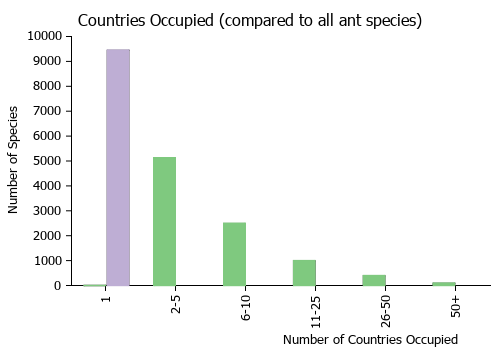
|
Estimated Abundance
| Relative abundance based on number of AntMaps records per species (this species within the purple bar). Fewer records (to the left) indicates a less abundant/encountered species while more records (to the right) indicates more abundant/encountered species. |

|
Biology
This species nests under a variety of conditions. At Volo it was taken in natural hummock in marshy ground near a larch-sphagnum bog. At New Lenox two colonies were found in a pasture, deep in the sod under rocks set in a dry ditch bank. At the E. S. George Reserve a huge colony was found beneath a layer of red woody soil under a dead standing tree in oak-hickory woods; the ants had galleried the roots of the dead trees into thin partitions. (Wilson 1955)
Castes
Worker
Images from AntWeb
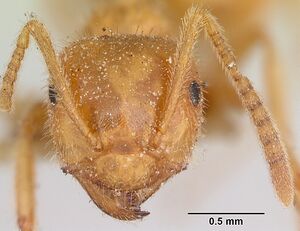   
| |
| Cotype of Lasius speculiventris. Worker. Specimen code casent0103508. Photographer April Nobile, uploaded by California Academy of Sciences. | Owned by USNM, Washington, DC, USA. |
Queen
   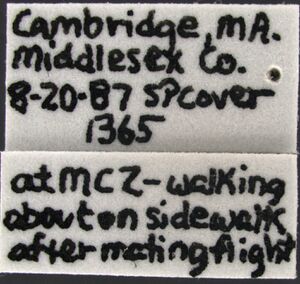
| |
| . | |
Images from AntWeb
   
| |
| Queen (alate/dealate). Specimen code casent0103509. Photographer April Nobile, uploaded by California Academy of Sciences. | Owned by USNM, Washington, DC, USA. |
Nomenclature
The following information is derived from Barry Bolton's Online Catalogue of the Ants of the World.
- speculiventris. Lasius speculiventris Emery, 1893i: 641 (w.m.) U.S.A. Wilson, 1955a: 172 (q.). Combination in L. (Chthonolasius): Emery, 1925b: 235. Subspecies of umbratus: Wheeler, W.M. 1910e: 237; Wheeler, W.M. 1917h: 167. Revived status as species: Creighton, 1950a: 423.
Unless otherwise noted the text for the remainder of this section is reported from the publication that includes the original description.
Description
Worker
Wilson (1955) - (1) Central area of exposed second gastric tergite, exclusive of the posterior strip, almost completely devoid of pubescence of any kind and with only a few widely scattered erect hairs, its cuticular surface extremely smooth and shining. The third and posterior tergites are usually very similar in this respect to the second, but the first tergite may have the bare area limited to a median longitudinal strip as narrow as one-fourth the width of the gaster (E. S. George Reserve, Mich.). Series at the opposite extreme (Caldwell, N. J.; Volo, Ill.; Chicago, Ill.) have no pubescence whatsoever on the gastric tergites except for thin zones along the posterior tergital margins.
(2) Standing appendage and cephalic pilosity ranging from extremely dense (scapes and legs covered with abundant, predominantly subdecumbent to erect hairs, and the margin of the head seen in full face from the mandibular insertions to the anterior borders of the eyes with more than 20 erect hairs) to less dense than the extreme hirsute form of Lasius umbratus (hairs on the scapes and legs mostly appressed-decumbent and seldom standing, and only one or two erect hairs along the genal contour). The type series exhibits the first extreme, and the Urbana, Ill., series, the second. There is no evident correlation between the density of the cephalic and anterior appendage pilosity and the density of the gastric pubescence.
Queen
(1) Gastric pubescence as in worker. Dorsal surfaces of second, third, and fourth tergites exclusive of the posterior strips almost completely devoid of pubescence. Dorsal surface of first tergite covered with appressed pubescence except for a thin, longitudinal, median strip about 0.15 mm. in width.
(2) Scapes and legs hairier than in all North American umbratus seen but still within range of variation of Eurasian series, Scape densely covered with short, predominantly decumbent hairs. Femora and tibiae with dense appressed pilosity and scattered short but outstanding decumbent hairs.
(3) In all other aspects. apparently identical to umbratus. Extreme HW rang.e 1.53-1.62 mm.
Male
(1) At least the median longitudinal fourth of the second and posterior gastric tergites devoid of pubescence, its cuticular surface smooth and shining; in the type series the entire dorsal gastric surface is devoid of hairs and strongly shining.
(2) Standing hairs more abundant on the head and alitrunk than in North American umbratus. In the type series, but not in another series from Ramsey Co., Minn., erect hairs are abundant along the genal contour viewed in full face.
(3) Extreme HW range 1.00-1.21 mm.
Type Material
Wilson (1955) - LECTOTYPE. By present selection, a worker in the Museum of Comparative Zoology labeled "Caldwell, N. J., Sept. 11 '88." Synnidotypes are in the Museum of Comparative Zoology, Emery Collection, American Museum of Natural History, and United States National Museum.
References
- Cantone S. 2017. Winged Ants, The Male, Dichotomous key to genera of winged male ants in the World, Behavioral ecology of mating flight (self-published).
- Carroll, T.M. 2011. The ants of Indiana (Hymenoptera: Formicidae). M.S. thesis, Purdue University.
- Creighton, W. S. 1950a. The ants of North America. Bulletin of the Museum of Comparative Zoology 104: 1-585 (page 423, revived status as species)
- Ellison, A.M., Gotelli, N.J., Farnsworht, E.J., Alpert, G.D. 2012. A Field Guide to the Ants of New England. Yale University Press, 256 pp.
- Emery, C. 1893k. Beiträge zur Kenntniss der nordamerikanischen Ameisenfauna. Zool. Jahrb. Abt. Syst. Geogr. Biol. Tiere 7: 633-682 (page 641, worker, male described)
- Emery, C. 1925d. Hymenoptera. Fam. Formicidae. Subfam. Formicinae. Genera Insectorum 183: 1-302 (page 235, Combination in L. (Chthonolasius))
- Ivanov, K. 2019. The ants of Ohio (Hymenoptera, Formicidae): an updated checklist. Journal of Hymenoptera Research 70: 65–87 (doi:10.3897@jhr.70.35207).
- Waters, J.S., Keough, N.W., Burt, J., Eckel, J.D., Hutchinson, T., Ewanchuk, J., Rock, M., Markert, J.A., Axen, H.J., Gregg, D. 2022. Survey of ants (Hymenoptera, Formicidae) in the city of Providence (Rhode Island, United States) and a new northern-most record for Brachyponera chinensis (Emery, 1895). Check List 18(6), 1347–1368 (doi:10.15560/18.6.1347).
- Wheeler, W. M. 1910h. The North American forms of Lasius umbratus Nylander. Psyche (Camb.) 17: 235-243 (page 237, Subspecies of umbratus)
- Wheeler, W. M. 1917h. The temporary social parasitism of Lasius subumbratus Viereck. Psyche (Camb.) 24: 167-176 (page 167, Subspecies of umbratus)
- Wilson, E. O. 1955a. A monographic revision of the ant genus Lasius. Bulletin of the Museum of Comparative Zoology 113: 1-201 (page 172, queen described)
References based on Global Ant Biodiversity Informatics
- Carroll T. M. 2011. The ants of Indiana (Hymenoptera: Formicidae). Master's Thesis Purdue university, 385 pages.
- Cole A. C. 1940. A Guide to the Ants of the Great Smoky Mountains National Park, Tennessee. American Midland Naturalist 24(1): 1-88.
- Coovert G. A. 2005. The Ants of Ohio (Hymenoptera: Formicidae). Ohio Biological Survey, Inc. 15(2): 1-207.
- Coovert, G.A. 2005. The Ants of Ohio (Hymenoptera: Formicidae) Ohio Biological Survey Bulletin New Series Volume 15(2):1-196
- Del Toro, I. 2010. PERSONAL COMMUNICATION. MUSEUM RECORDS COLLATED BY ISRAEL DEL TORO
- DuBois M. B. 1994. Checklist of Kansas ants. The Kansas School Naturalist 40: 3-16
- Dubois, M.B. and W.E. Laberge. 1988. An Annotated list of the ants of Illionois. pages 133-156 in Advances in Myrmecology, J. Trager
- Ellison A. M., E. J. Farnsworth, and N. J. Gotelli. 2002. Ant diversity in pitcher-plant bogs of Massachussetts. Northeastern Naturalist 9(3): 267-284.
- Ellison A. M., S. Record, A. Arguello, and N. J. Gotelli. 2007. Rapid Inventory of the Ant Assemblage in a Temperate Hardwood Forest: Species Composition and Assessment of Sampling Methods. Environ. Entomol. 36(4): 766-775.
- Ellison A. M., and E. J. Farnsworth. 2014. Targeted sampling increases knowledge and improves estimates of ant species richness in Rhode Island. Northeastern Naturalist 21(1): NENHC-13NENHC-24.
- Ivanov, K. 2019. The ants of Ohio (Hymenoptera, Formicidae): an updated checklist. Journal of Hymenoptera Research 70: 65–87.
- Lubertazi, D. Personal Communication. Specimen Data from Museum of Comparative Zoology at Harvard
- MacGown, J.A. and JV.G. Hill. Ants of the Great Smoky Mountains National Park (Tennessee and North Carolina).
- Nuhn, T.P. and C.G. Wright. 1979. An Ecological Survey of Ants (Hymenoptera: Formicidae) in a Landscaped Suburban Habitat. American Midland Naturalist 102(2):353-362
- Ouellette G. D. and A. Francoeur. 2012. Formicidae [Hymenoptera] diversity from the Lower Kennebec Valley Region of Maine. Journal of the Acadian Entomological Society 8: 48-51
- Sackett T. E., S. Record, S. Bewick, B. Baiser, N. J. Sanders, and A. M. Ellison. 2011. Response of macroarthropod assemblages to the loss of hemlock (Tsuga canadensis), a foundation species. Ecosphere 2(7):art74. doi:10.1890/ES11-00155.1
- Talbot M. 1965. Populations of ants in a low field. Insectes Sociaux 1: 19-48.
- Talbot M. 1976. A list of the ants (Hymenoptera: Formicidae) of the Edwin S. George Reserve, Livingston County, Michigan. Great Lakes Entomologist 8: 245-246.
- Wheeler G. C., J. N. Wheeler, and P. B. Kannowski. 1994. Checklist of the ants of Michigan (Hymenoptera: Formicidae). The Great Lakes Entomologist 26(4): 297-310
- Wheeler W. M. 1905. An annotated list of the ants of New Jersey. Bulletin of the American Museum of Natural History. 21: 371-403.
- Wheeler, G.C. and J. Wheeler. 1963. Ants of North Dakota
- Wheeler, G.C., J. Wheeler and P.B. Kannowski. 1994. CHECKLIST OF THE ANTS OF MICHIGAN (HYMENOPTERA: FORMICIDAE). Great Lakes Entomologist 26:1:297-310
- Wilson E. O. 1955. A monographic revision of the ant genus Lasius. Bulletin of the Museum of Comparative Zoology 113: 1-201
